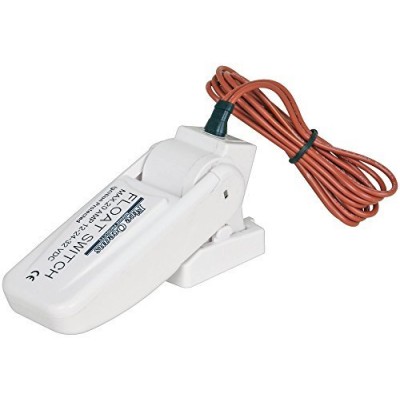Pond Pumps Canada is part of the Amazon Affiliate Network. We may receive payment for items purchased through the Amazon website.
These Five OceansŽ non-mercury heavy duty automatic float switches are manufactured in corrosion resistant and explosion proof material for the toughest applications.
The new mercury-free switches with "SNAP" movement have ultrasonic welding, making them reliable and secure.
> Long life, switching frequency up to 10 million times; Ultrasonic welding
> Turns pump on when water level reaches 2" (51mm)
> Turns pump off when water level reaches 3/4"(19mm)
> Shells made of high quality ABS material
> Ideal flow sensor for bilge pumps with removable base for easy cleaning and servicing
> Heavy duty flow switch is designed for the toughest applications; Environmentally responsible.
- Max Amps 12volts: 20A
- Max Amps 24volts: 10A
- Max Amps 32volts: 8A
- Wire Length: 3ft (1meter)
The new mercury-free switches with "SNAP" movement have ultrasonic welding, making them reliable and secure.
> Long life, switching frequency up to 10 million times; Ultrasonic welding
> Turns pump on when water level reaches 2" (51mm)
> Turns pump off when water level reaches 3/4"(19mm)
> Shells made of high quality ABS material
> Ideal flow sensor for bilge pumps with removable base for easy cleaning and servicing
> Heavy duty flow switch is designed for the toughest applications; Environmentally responsible.
- Max Amps 12volts: 20A
- Max Amps 24volts: 10A
- Max Amps 32volts: 8A
- Wire Length: 3ft (1meter)
- THIS FLOAT SWITCH is mercury free and is compatible with most 12V and 24V bilge pumps
- HEAVY-DUTY Switch for bilge pumps (20 Amps Max)
- TURNS pump ON when the water level reaches 2" (51mm)
- CONSTRUCTED from high-grade marine plastic and featuring a larger float for increased buoyancy to reduce on/off cycling
- DIMENSIONS: 5 1/8" (130 mm) x 1 23/32" (44 mm) x 2 1/8" (54 mm)
Five Oceans Bilge Pumps for Boats & RVs (Float Switch)
- Brand: Five Oceans
- Product Code: 3610
- Availability: In Stock
Available Options
Related Products
Amarine-made 1100gph 12v Boat Marine Plumbing Electric Bilge Pumps (1100gph 12v)
Features: The Amarine-made submersible bilge pumps are toug..
Dynamic Head
The effect of the Earths gravity on the "lift" or head pressure is fairly simple; for every vertical foot of distance the pump moves the water you are adding one foot of head pressure so the ratio is a 1:1 ratio. The effects of the friction, caused by water as it travels through your hose or pipes, on the total head pressure is a little more difficult to calculate especially as there are slight variations in pipe friction in different hose materials and the smoothness of the inner bore. Basically. for every ten feet of pipe through which the water has to travel travel horizontally will contribute 1 foot of head height; the ratio of the pipe friction loss is a 10:1 ratio.Plumbing fixtures and bends and corners in your hose also increase the total head you must calculate to ensure the proper final volume from your pump. Every corner with a 90 degree elbow in your plumbing will add 1 foot of head pressure with a 1:1 ratio. 45 degree elbows, tees and even insert couplers can all have an impact on the final flow.
If you install a pump 40 feet away from the top of your waterfall which is 6 feet above the pump and the tubing is a single run of 40 feet horizontally then you add 4 feet of head for the tubing length (the 10:1 ratio) to the 6 foot differnetial between the pump location and the final height of the waterfall so your final total dynamic head calculation would be 10 feet. This means your final volume of water flow in this water feature or application would be the volume of flow on the performance curve that equaled the gallons per hour at 16 feet. This volume will certainly be much less than the initial volume the pump can move at an open flow or a zero head.
If in the above example your 40 feet of horizontal tubing run also required 3 elbows of 90 degrees then an additional 3 feet of theoretical head would be added and your final flow result would be at 19 feet on the performance curve of the pump. In this example you would want to choose a pump that has the desired GPH rating at 9 feet of head pressure. Tubing size is also an important factor in accounting for head pressure loss, in general you should never reduce the diameter of the tubing below what the output size of the pump is, this will drastically increase head pressure, and reduce pump performance. For maximum pump performance, using the largest tubing that is practical is the best choice. A best practice is to use a hose with an inner diameter that is the same as your pumps outlet fitting.

